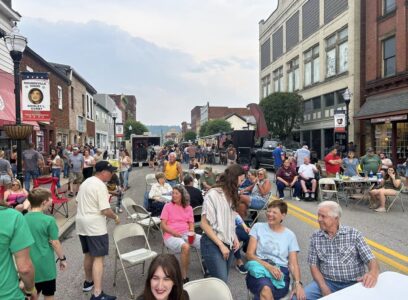Hancock County Commissioners Debate Best Use of Opioid Settlement Funds

photo by: Craig Howell
Hancock County commissioners, from left, Tommy Ogden, Eron Chek, and Paul Cowey, convened in a work session Monday morning to discuss possible procedures in the disbursement of the county's share of opioid settlement funds, setting a deadline of Dec. 17 to apply for the first round of county funds. Commissioners, though, couldn't agree on the best use of the funds.
Hancock County commissioners are looking further into opportunities to distribute some of the county’s allotment of West Virginia opioid settlement funds, although not everyone is in agreement into how those funds should be used.
Commissioners met in a work session Monday to discuss the distribution of almost $1.6 million provided to the county as a result of lawsuit settlements by the state with the manufacturers and distributors of opioids.
“We want to discuss our processes and policies for evaluating applications,” explained Commission President Eron Chek in opening the meeting.
County Administrator John Klee confirmed three applications for funds have been received as of Monday, with Commissioner Tommy Ogden indicating a fourth was being submitted.
While commissioners agreed to implement a deadline of Dec. 17 to apply for this round of funding, with a potential announcement of recipients for early January, they weren’t unanimous on the focus for the use of the money.
Ogden, noting the county’s recent — and potentially future — budget issues, suggested using a portion of the funds to ensure the adequate funding of the county sheriff’s department and volunteer fire departments.
He pointed to the county’s bills for housing prisoners in the West Virginia Northern Regional Jail, as well as support of the Lee Day Report Center, which he said was more than $700,000 last year, as ways to cut down on some of the county’s expenses.
“Those bills are a direct consequence of opioid abuse,” Ogden said.
In an email sent by Ogden after the meeting, he reinforced his thought of using some of the funds for county government.
“I think we should pay 700 or 800 thousand of county expenses out of the opioid fund, and then to keep that money to help offset any possible future reductions and bridge the financial gap between possible near term budget reductions and fiscal year end 28 which we believe will see county revenue increase,” Ogden wrote. “That would still leave $800,000 in the opioid fund, which will allow us to help many, many deserving programs but also keep a large chunk to help provide services and safety to all residents of Hancock County.”
Chek disagreed, saying the opioid funds were designed to support programs in the areas of education, emergency services, prevention, intervention or rehabilitation in an effort to combat opioid abuse, not to serve as a budgetary cushion.
“That’s supporting government. This money should be supporting communities,” Chek said.
Commissioner Paul Cowey agreed with Chek’s assessment.
“It’s not for a budget fix. It’s for a people fix,” Cowey said.
Chek emphasized the opioid funds should be considered as a one-time allotment to the county, and not relied on for regular expenditures.
“One thing government never does is spend money to solve a problem,” Chek said. “This is an opportunity.”
Commissioners approved an application in August for those interested in potentially receiving a portion of the opioid funds.
The application asks for the full name and FEIN of the interested entity, as well as an address and contact information, names of any board of directors members or officers, as well as the potential use of funds, its cost, and the amount being requested.
A digital copy may be found on the commission’s website, under the “Forms” tab.




